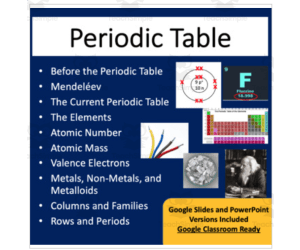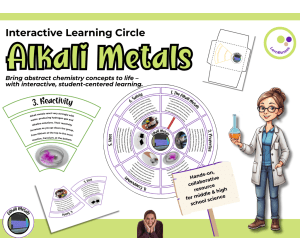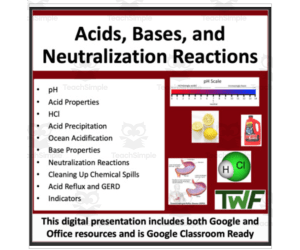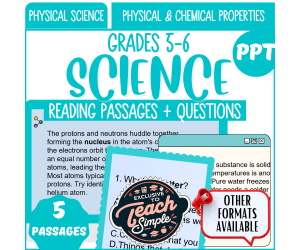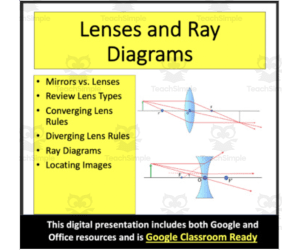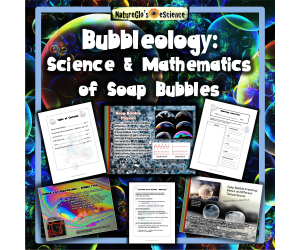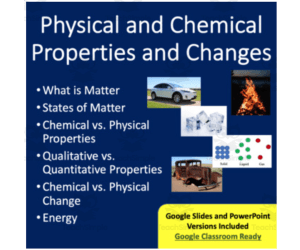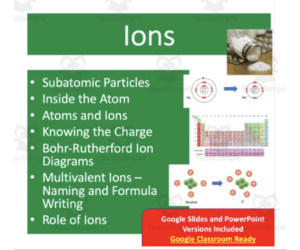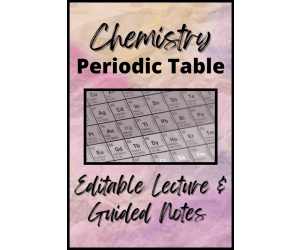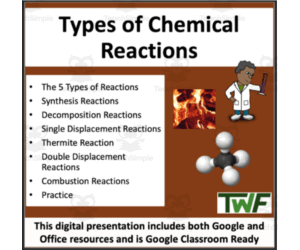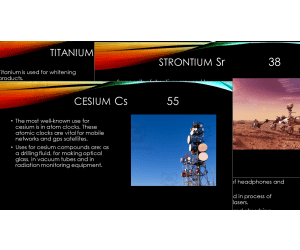2,741 products added recently
Chemistry Presentation
Make chemistry concepts accessible with presentations that explain atomic structure, bonding, and chemical reactions. These resources use diagrams and animations to illustrate ideas. Use them to engage your students and clarify challenging topics in chemistry.
Balancing Chemical Reactions Lesson - Google Slides and PowerPoint Lesson
Science, Chemistry, Grade 10, 11, 12, Presentations, Teacher Tools
Balancing Chemical Reactions - This lesson package includes the lesson (student and teacher versions of the presentation), THREE worksheets with answers, one embedded video, and a student lesson handout as a document. The lesson is interesting, applicable, and provides many opportunities for students to learn how to balance chemical reactions. In order, the lesson covers: An overview of the Law of Conservation of Mass Review of Chemical Reactions Rules for Balancing Lots of examples and practice Included in the lesson package is: Google and Office versions of each resource The teacher version of the presentation The student version of the presentation One embedded video THREE student worksheet Student lesson handout -------------------------------------------- This lesson includes both Office and Google formats for ALL resources. The presentation is in PowerPoint and Google Slides while all documents contain Word and Google Doc versions. Your resource is perfect for distance learning and integrates seamlessly with Google Classroom as I've included a link that will automatically create a copy of the resources and put them directly into your Google Drive with one click. Purchase --> Open --> Click --> Assign to your students Having both options allows you to use either without worrying about formatting issues as all the work has already been done for you. It safeguards you in case your department or school decides to go Google 100% and allows you as well as your students to access everything no matter where you are or what kind of equipment is being used. -------------------------------------------- The student version of the presentation contains multiple blanks that need to be filled in throughout the lesson. These blanks are conveniently underlined and bolded on the teacher copy. I have found this to be the most effective means of keeping my students engaged and active without having them write everything out. This also leaves more time for discussion and activities. Also, please visit my blog Teach With Fergy for my thoughts on teaching, learning, and everything in between.
Author Teach With Fergy
Tags Balancing Equations, Chemical Equations, Chemical Reactions, Formulas, Balancing Examples, Balancing Chemical Equations.ppt -.pdf
Chemistry: Unit 2 States of Matter PowerPoint and Lecture Guide
Science, Chemistry, Grade 9, 10, 11, Presentations, Teacher Tools
Chemistry: Unit 2 States of Matter PowerPoint and Lecture Guide This comprehensive teaching resource is specifically tailored to enhance high-school science teaching, specifically for grades 9, 10 and 11. Aligned with Florida's Next Generation Sunshine State Standards for Science, this educational tool will dramatically improve the education process. Inclusions of the Package: A detailed seven-page lecture guide.. An easy-to-follow 52-slide PowerPoint presentation on the States of Matter... The resource’s editable formats give educators an ability to tailor their lectures based on specific learning objectives or preferences. Contents Covered in PowerPoint Slides: Kinetic Molecular Theory (slides 2 -5)... Phase Changes Recall (slide6)… Kinetic Energy and States of Matter (slides7 -9)... The importance of revision is recognized by including review sections that ensure a comprehensive learning experience. Add-Ons: The states-of-matter presentation equips educators with answers or explanations central to every slide’s topic. These can either be projected on the slide itself or read from its notes section. The power-packed resource also covers heating/cooling curves, exothermic/endothermic processes, and phase diagrams . The final segment is Phase Diagram Practice displayed over ten slides as an interactive practice session. Note: Compatibility with Microsoft Word and Microsoft PowerPoint software is necessary for usage. In summary, 'Chemistry: Unit 2 States of Matter' PowerPoint & Lecture Guide proves to be a worthy tool for educators, advancing their teaching arsenal and their students' understanding of the states of matter.
Author Organized Chaos
Tags Chemistry, States Of Matter, Kinetic Molecular Theory, Phase Changes, Heating/Cooling Curves
The Periodic Table - Google Slides and PowerPoint Lesson
Science, Chemistry, Grade 7, 8, 9, Presentations, Teacher Tools
Periodic Table - Google Slides and PowerPoint Lesson This digital resource, designed for grade 7-9 science educators, brings life to the vast world of chemistry—specifically, the periodic table. This two-day lesson package engages students in interactive learning while providing teachers user-friendly resources in both office and Google formats. Topic Coverage History – Mendeleev Element squares Atomic number & atomic mass Valence electrons Metals/Non-metals and Metalloids Groups, families & periods . All themes are complemented by engaging videos with a correlating worksheet accessible directly from the presentation itself. User-Friendly Formatting All files come in Word along with Google Doc versions. The presentation materials are offered through PowerPoint or Google Slide formats for your convenience. Compatibility issues have been pre-adjusted for seamless use across all platforms. Versatile Usage Patterns : This kit can be used in whole-class discussions or small group activities. Even homework assignments derived from these resources would be beneficial due to its user-friendly design! Note: You just need one click via our link to automatically create copies of these educational tools that would reside straight into your personal drive making it an ideal fit within distance learning allocation or other such settings requiring easy access regardless of location or type of devices available!
Author Teach With Fergy
Tags Periodic Table, Chemistry, Digital Resource, Lesson Package, Google Slides, Periodic Table Google, Metals Nonmetals Metalloids Powerpoint
Interactive Chemistry Quiz: GHS Symbols – Genially + PDF Version
Science, STEM, Chemistry, Physics, Life Sciences, Earth and Environmental Sciences, Technology, Basic Science, Biology, P.E. & Health, Homeschool Templates, Grade 6, 7, 8, 9, 10, 11, Teacher Tools, Experiments, Activities, Labs, Worksheets & Printables, Escape Room, Games, Presentations, Quizzes and Tests, Quizzes
Interactive Chemistry Quiz: GHS Symbols – Genially (+ PDF Version) Bring lab safety to life with this interactive quiz on the GHS (Globally Harmonized System) hazard symbols – perfect for middle and high school chemistry lessons. Whether you're starting the unit or wrapping up a safety review, this quiz adds variety, visual appeal, and a bit of fun to your lesson plan. You’ll get two versions of the quiz: – A PDF version that can be used digitally or printed (but it works not well) – A Genially link that leads to an animated, interactive version (includes sound – which can be muted) Both versions test students on the meanings of the various GHS symbols – from corrosive substances to environmental hazards. The quiz includes original clipart and my own glitter-animated GHS symbols to make the content more visually appealing without distracting from the important safety message. I usually use the Genially quiz for individual work in the computer lab or on tablets, so each student can go at their own pace. But it also works well as a station activity , a class-wide quiz , or even as homework , depending on your classroom setup. At the end of the PDF, you’ll find: A QR code to scan directly to the Genially A clickable link for browser access An iframe embed code , if you want to use it on your (non-commercial) learning platform Attention: The interactive PDF does not contain the full scope of the material. The quiz works. Unfortunately, the additional tasks do not. Using Genially is therefore recommended and much more motivating for the pupils. For the interactive quiz you need an internet connection and a terminal device. The quiz can be carried out with the whole class or as partner or individual work. I prefer individual work at each student's own pace. To get to the Genially link, either scan the QR code at the end of the document or click on the link button available there. You can also copy the iframe code and embed the Genially on a learning platform or other... The Genially can be used either at the beginning of the topic or as a backup. It is also worth using as a station in station work. The interactive version includes motivating sound effects , a self-paced structure , and a clear, age-appropriate design for grades 7–10. 📌 Important note : The Genially quiz is protected by copyright. It’s for your own classroom use only . Please don’t share the link or embed it outside a private, secure learning environment. Sharing with colleagues, online platforms, or social media is not permitted. I hope your students enjoy reviewing GHS symbols as much as mine do! – Heike from @Lernfitness Did You Know? I teach with a certified therapy dog, and together we create a positive and welcoming learning environment. 🐶
Author Lernfitness
Rating
Tags GHS, Science, Lab, Chemistry, Pictograms, Genially, Interactive, Lab Safety, Hazard Symbols, Individual Work
Atomic Structure and Notation Lesson - Google Slides and PowerPoint Lesson
Science, Chemistry, Grade 7, 8, 9, Presentations, Teacher Tools
Atomic Structure and Notation Lesson. This lesson package introduces Atoms, Protons, Neutrons, and Electrons. Furthermore, it explains Atomic Number, Mass Number, and Atomic Symbols. This package includes the lesson (student and teacher versions of the presentation), an auto-graded Exit Ticket to check student understanding, a Bill Nye worksheet (includes answer key), and a student lesson handout as a document. This lesson includes both Office and Google formats for ALL resources. The presentation is in PowerPoint and Google Slides while all documents contain Word and Google Doc versions. Your resource is perfect for distance learning and integrates seamlessly with Google Classroom as I've included a link that will automatically create a copy of the resources and put them directly into your Google Drive with one click. Purchase --> Open --> Click --> Assign to your students Having both options allows you to use either without worrying about formatting issues as all the work has already been done for you. It safeguards you in case your department or school decides to go Google 100% and allows you as well as your students to access everything no matter where you are or what kind of equipment is being used. Included in the lesson package is: - Office and Google versions of the presentation - The teacher version of the presentation - The student version of the presentation - An auto-graded Exit Ticket - Bill Nye video worksheet - Student worksheet - Student lesson handout In order, the lesson covers: - Atoms - Protons - Neutrons - Electrons - Atomic Number - Mass Number - Atomic Symbols - Calculations The student version of the PowerPoint contains multiple blanks that need to be filled in throughout the lesson. These blanks are conveniently underlined and bolded on the teacher copy. I have found this to be the most effective means of keeping my students engaged and active without having them write everything out. This also leaves more time for discussion and activities. I also have a range of assignments and lessons/units from other grade levels at my store. Please CLICK HERE to have a look around and don’t forget to follow if you like what you see. Also, please visit my blog Teach With Fergy for my thoughts on teaching, learning and everything in between.
Author Teach With Fergy
Tags Atomic Structure, Atomic Notation, Atomic Structure And Notation, Chemistry Lesson, Atomic Structure Ppt Middle School
Chemistry Blackboard Cards – Chemical Elements 1–118
STEM, Science, Chemistry, Physics, Life Sciences, Montessori, Basic Science, Grade 7, 8, 9, 10, 11, 12, Activities, Worksheets & Printables, Task Cards, Teacher Tools, Flashcards, Classroom Decor, Door Decor, Bulletin Boards, Posters, Presentations
Chemistry Blackboard Cards – Chemical Elements 1–118 Visual support for teaching the periodic table in grades 7–11 🧪🧲 This printable set contains blackboard-sized cards for all 118 chemical elements, designed to make the periodic table more accessible and interactive in your classroom. Each card includes the element’s name, atomic number, and chemical symbol in a clean, easy-to-read format – perfect for whiteboard work, displays, and hands-on sorting tasks. The cards are arranged two per A4 page and can be printed, laminated, and reused across many lessons. I’ve used them to build a large-scale classroom periodic table, support sorting games by group or period, and even for spontaneous quizzes at the board. What’s included: 118 blackboard cards (PDF format) Each card shows: element name, chemical symbol, atomic number 2 cards per A4 page for easy printing Black-and-white, ideal for printing and possible color-coding How it’s used in class: These cards are great for front-of-class instruction but also work well in group activities or as a station-based task. Students can work in teams to arrange the elements in correct order, match symbols to names, or explore relationships between groups and periods. Because the design is simple and consistent, students can focus on the content rather than being distracted by layout. The cards support visual learning and active participation. They’re especially useful for mixed-ability classes: more confident students might work from memory, while others use a printed periodic table for support. You can also let students take on teaching roles by explaining selected elements to peers at the board. This is a practical tool for visualizing chemistry concepts – no extra prep required beyond printing and cutting. Laminate for longer use. 📍 Best wishes, Heike from @Lernfitness Did You Know? I teach with a certified therapy dog, and together we create a positive and welcoming learning environment. 🐶
Author Lernfitness
Rating
Tags Educational Card Games, Chemistry, Physics, STEM Science Matching Game, Chemical Elements, Periodic Table Matching Game, Game, Flashcards, Blackboard Cards, Blackboard
Alkali Metals Concept Wheel – Interactive Chemistry Activity for Grade
STEM, Science, Chemistry, Physics, Life Sciences, Grade 7, 8, 9, 10, 11, 12, Activities, Games, Worksheets & Printables, Quizzes and Tests, Teacher Tools, Worksheets, Flashcards, Projects, Presentations, Graphic Organizers
Alkali Metals Concept Wheel – Interactive Chemistry Activity for Grades 7–10 Learn Alkali Metals - visual learning 🧪🧠 This concept wheel is a practical way to help students understand the alkali metals in Group 1 of the periodic table. I first made it for a grade 8 class that was struggling with the idea of chemical families. Instead of giving them another chart to copy, I tried this wheel activity, and it worked much better because they could see and handle the information piece by piece. The wheel has eight sections that cover the basics: general properties, reactivity, how these elements appear in nature, and some everyday uses. Students cut out and arrange the pieces to build the full circle. The activity takes a little bit of preparation, but once the pieces are made, you can reuse them. I usually store the sets in small envelopes so they are ready for the next lesson. There are different versions included. Some circles are already filled in, which is helpful when introducing the topic for the first time. Others are blank, so students can write their own notes after a lab or reading assignment. I have used the blank ones during review sessions, and students liked comparing their wheels with a partner’s version. It also gives them a sense of ownership over the material. The wheel can be used in many ways: as a warm-up before a lab, as practice during a unit on the periodic table, or as a review before a quiz. It works for group tasks, but I have also had students complete it on their own. When the wheels are finished, they make a clear visual display for the classroom or for a student’s notebook. This activity is designed for grades 7–10 chemistry or physical science. It supports lessons on periodic trends, classification of elements, and the special role of the alkali metals. 📍 Best wishes, Heike from @Lernfitness Did You Know? I teach with a certified therapy dog, and together we create a positive and welcoming learning environment. 🐶
Author Lernfitness
Rating
Tags Educational Card Games, Chemistry, Physics, STEM Science Matching Game, Chemical Elements, Periodic Table Matching Game, Alkali Metals, Periodic Table, Learning Circle
Acid, Bases, and Neutralization Reactions - Google Slides and PowerPoint Lesson
Science, Chemistry, Grade 9, 10, 11, Presentations, Teacher Tools
Acids and Bases - This TWO-DAY lesson package includes the lesson (student and teacher versions of the presentation), TWO worksheets with answers, FOUR embedded videos, and a student lesson handout as a document. The lesson is interesting, applicable, and provides many opportunities for students to learn about the five main kinds of chemical reactions. In order, the lesson covers: pH Acid Properties HCl Acid Precipitation Ocean Acidification Base Properties Neutralization Reactions Cleaning Up Chemical Spills Acid Reflux and GERD Indicators Included in the lesson package is: Google and Office versions of each resource The teacher version of the presentation The student version of the presentation EIGHT embedded videos Student lesson handout -------------------------------------------- This lesson includes both Office and Google formats for ALL resources. The presentation is in PowerPoint and Google Slides while all documents contain Word and Google Doc versions. Your resource is perfect for distance learning and integrates seamlessly with Google Classroom as I've included a link that will automatically create a copy of the resources and put them directly into your Google Drive with one click. Purchase --> Open --> Click --> Assign to your students Having both options allows you to use either without worrying about formatting issues as all the work has already been done for you. It safeguards you in case your department or school decides to go Google 100% and allows you as well as your students to access everything no matter where you are or what kind of equipment is being used. -------------------------------------------- The student version of the presentation contains multiple blanks that need to be filled in throughout the lesson. These blanks are conveniently underlined and bolded on the teacher copy. I have found this to be the most effective means of keeping my students engaged and active without having them write everything out. This also leaves more time for discussion and activities. This lesson can also be found within my Chemistry Unit which also includes the following lessons: Lesson 1 - Physical/Chemical Properties and Changes Lesson 2 - Periodic Table and Bohr Rutherford Diagrams Lesson 3 - Lewis Structures Lesson 4 - Ions Lesson 5 - Ionic Compounds Lesson 6 - Polyatomic Compounds Lesson 7 - Molecular Compounds Lesson 8 - Chemical Reactions Introduction Lesson 9 - Balancing Chemical Reactions Lesson 10 - Types of Chemical Reactions Lesson 11 - Acid, Bases, and Neutralization Reactions I also have a range of assignments and lessons/units from other grade levels at my store. Please CLICK HERE to have a look around and don’t forget to follow if you like what you see. Also, please visit my blog Teach With Fergy for my thoughts on teaching, learning, and everything in between.
Author Teach With Fergy
Tags Chemistry Lesson, Science Lesson, Student Notes, Acids, Bases, Acid Base Power Point, Acids And Bases Powerpoints
Chemistry: Unit 1 Introduction to Chemistry PowerPoint and Lecture Guide
Science, Chemistry, Grade 8, 9, 10, 11, Presentations, Teacher Tools
Chemistry: Unit 1 Introduction to Chemistry PowerPoint and Lecture Guide A valuable resource for public school teachers and homeschoolers focusing on students in grade 8 to 11, delivering a versatile teaching tool comprised of interactive activities designed to engage students actively. Document types: Microsoft Word, Microsoft PowerPoint, PDF formats; Please note: Ensure these document types are compatible with your computer; Included activities:a number line activity , a bullseye accuracy/precision activity . Lecture Guide An informative 11-page lecture guide paved with pivotal concepts required to master introductory chemistry. Hundred Fifteen Slides PowerPoint Presentation The package includes an easy-to-follow PowerPoint presentation laced with 115 slides. These showcase essential topics mapped according to Florida's Next Generation Sunshine State Standards for Science. Each topic addressed ensures thorough coverage paved by explanations incorporated into every slide or added into the notes area for teachers' convenience. Pivotal Topics Included Within the Package : Safety Symbols. The Scientific Method Review. Fundamentals of Accuracy & Precision. A deep dive on Significant Figures & Dimensional Analysis et al.. important aspects towards understanding rudimentary Chemistry. Note: All materials - activities, lecture guide plus the PowerPoint Presentation - are customizable assuring maximum flexibility suited depending on each class's specific needs or individual pace of learners if homeschooled. Finally, Feel free to contact for any clarification regarding this multi-level learning tool.
Author Organized Chaos
Tags Chemistry, Teaching Resource, Interactive Activities, Lecture Guide, PowerPoint Presentation
Science Reading Passages on Physical and Chemical Properties (PPT)
Science, Physics, Common Core, Reading Comprehension, Reading, ELA, ESL, Language Development, Resources for Teachers, Chemistry, Grade 5, 6, 7, Teacher Tools, Presentations, Tests, Quizzes and Tests, Diagrams, Assessments, Activities
Reading Passages on Physical and Chemical Properties for Physical Science (Biology) Physical and Chemical Properties: Reading Passages Physical Science - Stimulate renewed enthusiasm and curiosity in the realm of science with these vibrant science reading comprehension lessons. Bursting with vivid colors and engaging topics, these resources are designed to captivate and motivate your students, urging them to delve deeper into their scientific explorations. And the best part? As an educator, you can be at ease and confident in the effectiveness of these lessons, knowing that a significant portion of the groundwork and preparation has been meticulously taken care of for you, making the teaching process smoother and more enjoyable. What's inside? Physical & Chemical Properties Reading Passage1: Measuring Matter: Mass, Volume, and Density Reading Passage2: Physical and Chemical Properties of Matter Reading Passage 3: Physical and Chemical Changes in Matter Reading Passage4: Atoms, Elements, and Compounds Reading Passage5: Chemicals: Helpful and Harmful Product Info: 186 slides Teaching Duration: 2 Weeks Science Reading Comprehension Outline: Introducing a comprehensive resource tailored for 5th and 6th graders, this product offers enriching reading passages supplemented with illustrative pictures and graphs to clarify key concepts. Aligned with the Common Core State Standards (CCSS), it offers a hassle-free approach to teaching, given that the bulk of the preparation is already done for you. The passages present a diverse set of questions – from multiple choice to data analysis and fill-in-the-blanks. This ensures a rich blend of high-interest content and fundamental curriculum -based science themes. With its versatility, you can seamlessly integrate these lessons into various classroom settings, whether it's whole class discussions, morning exercises, independent desk tasks, small group engagements, contingency plans for substitute teachers, regular homework assignments, or even themed activities for holidays. FULL CATALOG OF DOWNLOAD LINKS HERE Grade 5/6 Links: Physical Science Part 1 - Physical and Chemical Properties Google Docs/Slides/Forms PDF PPT Word Free Supplementary Pack Accompanying Videos Physical Science Part 2 - Motion and Energy Google Docs/Slides/Forms PDF PPT Word Free Supplementary Pack Accompanying Videos Physical Science Part 3 - Electricity and Magnets Google Docs/Slides/Forms PDF PPT Word Free Supplementary Pack Accompanying Videos Life Science Part 1 - Cells, Reproduction and Genetics Google Docs/Slides/Forms PDF PPT Word Free Supplementary Pack Accompanying Videos Life Science Part 2 - Human Body Systems Google Docs/Slides/Forms PDF PPT Word Free Supplementary Pack Accompanying Videos Life Science Part 3 - Plant Parts and Ecosystems Google Docs/Slides/Forms PDF PPT Word Free Supplementary Pack Accompanying Videos Earth Science Part 1 - Plate Tectonics and Rock Cycle Google Docs/Slides/Forms PDF PPT Word Free Supplementary Pack Accompanying Videos Earth Science Part 2 - Ocean Exploration and Natural Resources Google Docs/Slides/Forms PDF PPT Word Free Supplementary Pack Accompanying Videos Earth Science Part 3 - Weather and Solar System Google Docs/Slides/Forms PDF PPT Word Free Supplementary Pack Accompanying Videos For similar products and other frees, do check out Cored Group on TeachSimple .
Author Cored Education
Rating
Tags Science, Reading, Comprehension, Vocabulary, Physics, Physical Science, PPT, Presentations, Reading Comprehension Presentations, Physics Presentations
Lenses and Ray Diagrams - Optics - Google Slides and Distance Learning
Science, Chemistry, Grade 8, 9, 10, Presentations, Teacher Tools
Lenses and Ray Diagrams - Optics - Google Slides and Distance Learning is a comprehensive unit! Everything you need to introduce or review Lenses and Ray Diagrams is right here including the lesson (student and teacher versions), an auto-graded Exit Ticket to check for student understanding, a Bill Nye video and worksheet (worksheet answer key), and a student lesson handout. The presentation is interactive, engaging, and classroom tested. In order, the lesson covers: Types of Lenses Review Ray Diagrams - overview Ray Diagrams - different rays Ray Diagrams - converging lens Ray Diagrams - diverging lens Included in the lesson package is: Google and Office versions of the presentation and all documents The teacher version of the presentation The student version of the presentation Practice problems with video-guided answer walkthrough - I created a video that solves the problem from start to finish Snell's Lab In-Class Lab An auto-graded Exit Ticket Student lesson handout Digital and Distance Learning: This lesson is fully digital which makes it perfect for the classroom, distance learning, or as a sub-plan if needed. With a single click, the entire package will be imported into your Google Drive and will be ready to assign to your students or present in class. You can also place a copy of the resources directly into student Google Drive accounts for easy access. Included in your package is an Exit Ticket which can be directly accessed from the last Google Slide. Additionally, your purchase will create a copy of the Google Form Exit Ticket which you can edit to meet your class needs. Student Version: The student version of the lesson contains multiple blanks that need to be filled in throughout. These blanks are conveniently underlined and bolded on the teacher copy. I have found this to be the most effective means of keeping my students engaged and active without having them write everything out. This also leaves more time for discussion and activities. -------------------------- I also have a range of assignments and lessons/units from other grade levels at my store. Please CLICK HERE to have a look around.Lenses and Ray Diagrams - Optics - Google Slides and Distance Learning Also, please visit my blog Teach With Fergy for my thoughts on teaching, learning, and everything in between.
Author Teach With Fergy
Tags Lens Rules, Lens Type, Ray Diagrams, Locating Images, Science Lesson
Soap Bubbles PowerPoint Unit Study
Science, Chemistry, Grade 3, 4, 5, 6, 7, 8, Presentations, Teacher Tools
Soap Bubble PowerPoint Unit Study Introduction Soap bubbles are a tried and true fascination for kids for a reason. There's just something so magical about a soapy solution that creates beautiful rainbow irridescent floating bubbles of varying sizes. This soap bubble thematic unit will get you and your classroom down a learning rabbit hole adventure like no other. Learn about the science, math, history, art and even chemistry of soap bubbles. Your classroom can make its own soap bubble recipe and got out into your school yard and create a magical outdoor learning experience you and your students will want to replicate every year! Objectives: Describe what soap bubbles are in one sentence Write the mathematical relationship found in soap bubbles Complete a soap bubble project Grades: 3 - 8 Implementation Format: Show the PowerPoint to students. Students fill out the study guide. Learners go to the Soap Bubbles web page and explore the Internet activities including web pages, activities and videos Students can optionally complete a soap bubble project as a whole class or individual chosen projects. Answer Key: Yes. It's found in the study guide. File Types: PowerPoint and PDF Number of Pages: 33
Author NatureGlo's eScience
Tags Soap Bubbles, Unit Study, Thematic Unit, Chemistry, Soap Bubble Unit Study, Soap Bubbles Unit, Soap Bubbles Thematic Unit
Types of Chemical Bonds - Senior Chemistry - Google Slides and PowerPoint Lesson
Science, Chemistry, Grade 11, 12, Presentations, Teacher Tools
This chemistry lesson package starts by looking at forces of attraction - intramolecular and intermolecular and compares ionic and covalent bonds. It then looks at single, double, and triple bonds, polar covalent bonds, and metallic bonds. It is geared towards students who are in high school chemistry, either junior or senior years. This chemistry lesson package includes the lesson (student and teacher versions of the presentation), an auto-graded Exit Ticket, and a student lesson handout as a document. The presentation is fun and applicable with many opportunities for inquiry-based learning and discussion. In order, the lesson covers: Forces of Attraction Ionic vs. Covalent Bonds Ionic Bonds Overview Covalent Bonds Single, Double and Triple Bonds Polar Covalent Bonds Metallic Bonds Google and Distance Learning Ready This lesson includes both Office and Google formats for ALL resources. The presentation is in PowerPoint and Google Slides while all documents contain Word and Google Doc versions. Your resource is perfect for distance learning and integrates seamlessly with Google Classroom as I've included a link that will automatically create a copy of the resources and put them directly into your Google Drive with one click. Purchase --> Open --> Click --> Assign to your students Having both options allows you to use either without worrying about formatting issues as all the work has already been done for you. It safeguards you in case your department or school decides to go Google 100% and allows you as well as your students to access everything no matter where you are or what kind of equipment is being used. Included in the lesson package is: Google and Office versions of each resource The teacher version of the presentation The student version of the presentation Auto-graded Exit Ticket Student lesson handout The student version of the presentation contains multiple blanks that need to be filled in throughout the lesson. These blanks are conveniently underlined and bolded on the teacher copy. I have found this to be the most effective means of keeping my students engaged and active without having them write everything out. This also leaves more time for discussion and activities. Within my Matter, Chemical Trends, and Chemical Bonding Unit you can find the following lessons: Lesson 1 - Atomic Theory and Structure Overview Lesson 2 - Trends In The Periodic Table Lesson 3 - Types of Chemical Bonds Lesson 4 - Lewis Structures Lesson 5 - Nomenclature - Ionic Compounds and Multivalents Lesson 6 - Nomenclature - Polyatomics and Covalent Compounds Lesson 7 - Intermolecular Forces I also have a range of assignments and lessons/units from other grade levels at my store. Please CLICK HERE to have a look around and don’t forget to follow if you like what you see. Also, please visit my blog Teach With Fergy for my thoughts on teaching, learning, and everything in between.
Author Teach With Fergy
Tags Chemistry, Bonds, Bonding
Physical and Chemical Properties and Changes-Google Slides and PowerPoint Lesson
Science, Chemistry, Grade 7, 8, 9, Presentations, Teacher Tools
Physical and Chemical Properties and Changes. This TWO-DAY package includes the lesson (student and teacher versions of the presentation), an auto-graded Exit Ticket to check student understanding, 3 student worksheets (including 1 Bill Nye), and a student lesson handout as a document. The presentation is fun and engaging with a worksheet built right into the lesson. In order, the lesson covers: Matter States of Matter Physical & Chemical Properties Quantitative vs. Qualitative Properties Physical & Chemical Changes Energy Included in the lesson package is: Google and Office versions of each resource The teacher version of the presentation The student version of the presentation Auto-graded Exit Ticket THREE videos embedded into the presentation Student lesson handout -------------------------------------------- This lesson includes both Office and Google formats for ALL resources. The presentation is in PowerPoint and Google Slides while all documents contain Word and Google Doc versions. Your resource is perfect for distance learning and integrates seamlessly with Google Classroom as I've included a link that will automatically create a copy of the resources and put them directly into your Google Drive with one click. Purchase --> Open --> Click --> Assign to your students Having both options allows you to use either without worrying about formatting issues as all the work has already been done for you. It safeguards you in case your department or school decides to go Google 100% and allows you as well as your students to access everything no matter where you are or what kind of equipment is being used. -------------------------------------------- The student version of the lesson contains multiple blanks that need to be filled in throughout the lesson. These blanks are conveniently underlined and bolded on the teacher copy. I have found this to be the most effective means of keeping my students engaged and active without having them write everything out. This also leaves more time for discussion and activities. This lesson can also be found within my Chemistry Unit which also includes the following lessons: Lesson 1 - Physical/Chemical Properties and Changes Lesson 2 - Periodic Table and Bohr Rutherford Diagrams Lesson 3 - Lewis Structures Lesson 4 - Ions Lesson 5 - Ionic Compounds Lesson 6 - Polyatomic Compounds Lesson 7 - Molecular Compounds Lesson 8 - Chemical Reactions Introduction Lesson 9 - Balancing Chemical Reactions Lesson 10 - Types of Chemical Reactions Lesson 11 - Acid, Bases, and Neutralization Reactions I also have a range of assignments and lessons/units from other grade levels at my store. Please CLICK HERE to have a look around and don’t forget to follow if you like what you see. Also, please visit my blog Teach With Fergy for my thoughts on teaching, learning, and everything in between.
Author Teach With Fergy
Tags Physical Properties, Chemical Properties, Chemistry, Bill Nye & Chemical Reactions Student Worksheet, Physical And Chemical Properties Of Matter Powerpoint, Bill Nye Physical And Chemical
Ions Introduction Lesson - Google Slides and PowerPoint Lesson
Science, Chemistry, Grade 10, 11, 12, Presentations, Teacher Tools
The Ions Introduction Lesson, available in both Google Slides and PowerPoint format, is a comprehensive package designed to teach students about ions effectively. It suits educators who aim at providing an engaging yet deep understanding of this complex chemistry topic to grade 10, 11, and 12 students. Lesson Overview: An overview of ions including their net charge. A review of electrons and protons. Introduction to the concept of cations and anions. Determining the charge of an ion helps pupils grasp associated complexities while presenting Lewis structures brings visibility to atom components. Naming Ions: Naming Ions is another interesting section that prepares learners for advanced studies as they gain fluency in chemical jargon. Multivalent ions are explored within this guide too - an advanced topic introduction often avoided in conventional classrooms but crucial for higher-level chemistry understanding. Applications: The applications related section forms another significant feature nurturing practical knowledge application ability within participants which enhances long-term retention. The interactive presentation techniques make learning genuinely enjoyable leading towards improved academic outcomes. Emphasizing evaluation and feedback, the package includes auto-graded exit tickets, student worksheets replete with answers allowing teachers to save on preparation hours invested typically before lessons assignments or tests marking. Digital Teaching: What distinguishes this resource truly is its attention towards digitized teaching involved convenience: on purchase completion prospective buyers receive instant access formats suiting both Office applications or Google platforms tools preferences amid distance-learning adopting educators. The included teacher copy has blanks that need filling during the ongoing lesson promoting active participation rather than passive note-writing thereby improving attention span too. This package forms just one component within the broader Chemistry Unit, which encompass modules on various other relevant topics linking chemistry syllabus effectively and efficiently.
Author Teach With Fergy
Tags Ions, Net Charge, Electrons, Protons, Lewis Structures
Chemistry: Unit 6 Periodic Table & Trends PowerPoint and Lecture Guide
Science, Chemistry, Grade 9, 10, 11, Presentations, Teacher Tools
This resource is provided in both a Microsoft Word and a Microsoft PowerPoint document. Please make sure that your computer can accommodate this resource before purchasing. This resource includes an 6 page lecture guide and a simple 63 slide PowerPoint for Atomic Theory. The topics are in accordance with Florida's Next Generation Sunshine State Standards for Science. Answers and explanations are included on either the slide or in the notes section of the PowerPoint. Please note that both the lecture guide and PowerPoint are editable. Please do not hesitate to contact me with any questions. Topics Included: History of the Periodic Table (slides 1-9) Review & Throwback Question (slides 10-13) Groups on Periodic Table (slides 14-28) Periodic Trends: effective nuclear charge, ionic radius, shielding, atomic radius, electronegativity and ionization (slides 29-41) Metals, Nonmetals & Metalloids (slides 42-45) Unit Review Questions and Explanations (slides 46-63)
Author Organized Chaos
Tags PowerPoint, Periodic Table, Lecture Guide, Periodic Trends, Unit Notes, Periodic Table Powerpoint
Chemistry: Unit 3 Atomic Theory PowerPoint and Guided Notes
Science, Chemistry, Grade 9, 10, 11, Presentations, Teacher Tools
Chemistry: Unit 3 Atomic Theory PowerPoint and Guided Notes This comprehensive study guide is an invaluable resource for chemistry educators focusing on Atomic Theory. The content has been designed to be easy-to-follow, making it perfect for structured yet engaging sessions in public school classes or homeschooling environments. This dynamic learning material consists of two Microsoft documents: a guided lecture booklet and a carefully formulated PowerPoint presentation. Both align with Florida's Next Generation Sunshine State Standards for Science, catering primarily to Grade 9 to Grade 11 chemistry syllabi. PPT Presentation: A solid collection of 53 slides, each rich with actionable knowledge. Lecture Notes: An expansive yet detailed guide spanning 11 pages. The topics covered in this educational package have been methodically assembled, beginning subtly before gradually leading into more complicated arenas. These include: The key Atomic Scientists and their contribution; An exploration into the Structure of the Atom; A deep-dive into deciphering the Periodic Table; An elucidation on Isotopes; A detailed discourse on Ions; and wrapping up with A concrete conclusion discussing 'Average Atomic Mass.' All topics are supplementarily accompanied by textual answers or explanations along graphic illustrations—either placed directly onto slides or expounded in the notes section—enhancing comprehension throughout. Bonus Point:All elements within this resource, including lecture guide and PowerPoint slides are fully editable! This equips educators to tailor content according to their teaching style and the individual needs of their students. This resource enables teachers to achieve academic goals through data-backed lesson plans. It ensures that pupils remain attentive throughout their educational journey, providing them with tangible connections linking theory with practical applications—all these consolidating into a rich narrative in Chemistry's quintessential Unit 3: Atomic Theory.
Author Organized Chaos
Tags Atomic Theory, Chemistry Education, Guided Notes, PowerPoint, Next Generation Science Standards, High School Chemistry Powerpoints
Types of Chemical Reactions - Google Slides and PowerPoint Lesson
Science, Chemistry, Grade 9, 10, 11, Presentations, Teacher Tools
Types of Chemical Reactions - This TWO-DAY lesson package includes the lesson (student and teacher versions of the presentation), TWO worksheets with answers, FOUR embedded videos, and a student lesson handout as a document. The lesson is interesting, applicable, and provides many opportunities for students to learn about the five main kinds of chemical reactions. In order, the lesson covers: An overview of the 5 main types of reactions Details on Synthesis Reactions Decomposition Reactions Single Replacement Reactions Double Replacement Reactions Combustion (complete and incomplete) Reactions Lots of examples and practice Included in the lesson package is: Google and Office versions of each resource The teacher version of the presentation The student version of the presentation One embedded video THREE student worksheet Student lesson handout -------------------------------------------- This lesson includes both Office and Google formats for ALL resources. The presentation is in PowerPoint and Google Slides while all documents contain Word and Google Doc versions. Your resource is perfect for distance learning and integrates seamlessly with Google Classroom as I've included a link that will automatically create a copy of the resources and put them directly into your Google Drive with one click. Purchase --> Open --> Click --> Assign to your students Having both options allows you to use either without worrying about formatting issues as all the work has already been done for you. It safeguards you in case your department or school decides to go Google 100% and allows you as well as your students to access everything no matter where you are or what kind of equipment is being used. -------------------------------------------- The student version of the presentation contains multiple blanks that need to be filled in throughout the lesson. These blanks are conveniently underlined and bolded on the teacher copy. I have found this to be the most effective means of keeping my students engaged and active without having them write everything out. This also leaves more time for discussion and activities. I also have a range of assignments and lessons/units from other grade levels at my store. Please CLICK HERE to have a look around and don’t forget to follow if you like what you see. Also, please visit my blog Teach With Fergy for my thoughts on teaching, learning, and everything in between.
Author Teach With Fergy
Tags Chemical Reactions, Chemistry
Use of Chemical Elements Editable PowerPoint Presentation
Science, Chemistry, Grade 6, 7, 8, 9, Teacher Tools, Presentations
Overview The Use of Chemical Elements Editable PowerPoint Presentation is a comprehensive resource designed to aid in-depth understanding of chemical elements, their properties, and applications. The content is tailored for educators and students in grade 6 through 9. Main Features Detailed information about each chemical element from Hydrogen (H, atomic number 1) to Californium (Cf, atomic number 98). Straightforward representation of complex topics using relatable examples. Slide-numbering corresponds with the atomic numbers for easy location of elements within the material. All elements between numbers 99-118 are condensed into one slide due to their lesser-known uses. Note: The presentation should be used as supplementary content rather than main teaching material. It acts as a complement to standard textbooks by covering areas where they might fall short. Editability & Customizability: A standout feature of this resource is that users can edit all parts freely - invaluable for teachers wanting to insert extra details or customize delivery approaches according to individual teaching styles or student's needs. This makes it perfect not only for regular classes but also suitable for small study groups. Beyond just serving as an excellent tool in teaching Science and Chemistry topics, this visual-rich resource fosters better comprehension while encouraging interest among students - leading potentially higher retention rates. Lastly, it also proves useful homework assignment reference material. Incorporate the 'Use of Chemical Elements Editable PowerPoint Presentation ' into your educational toolkit today!. .
Author TheBrightestKid
Tags Chemical Elements, Applications, Classroom Resource, Editable Presentation, Teaching Tool




